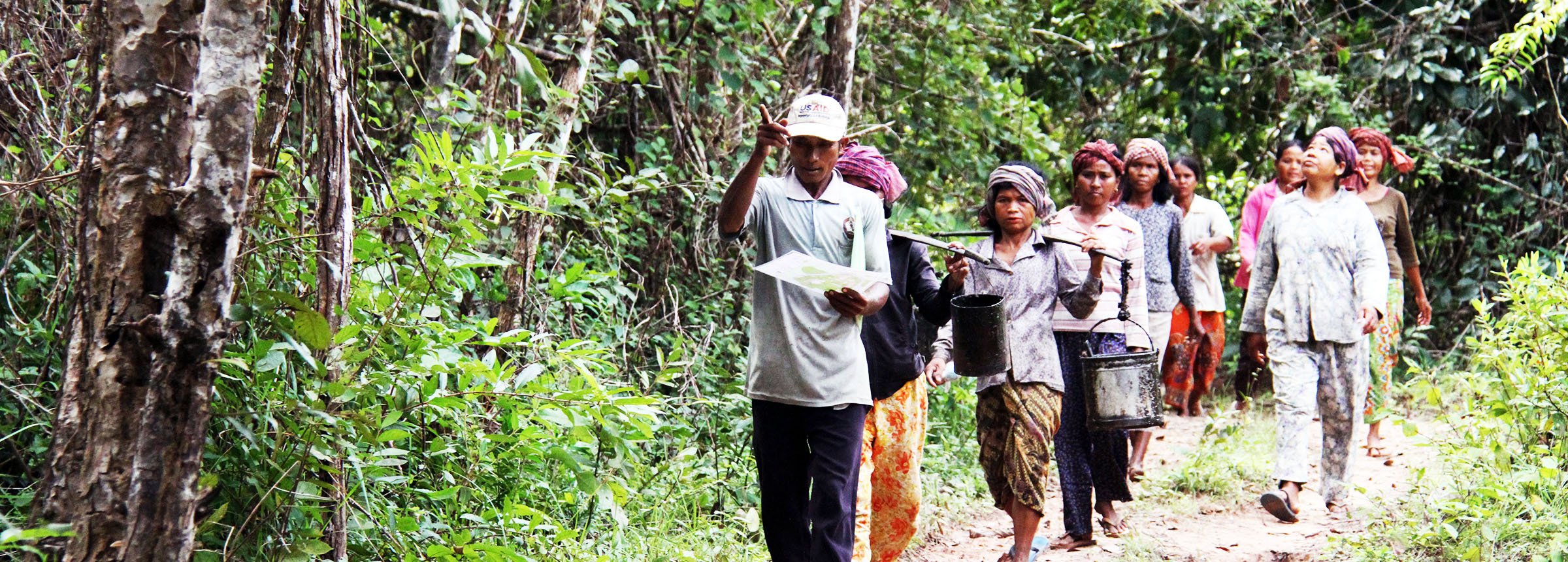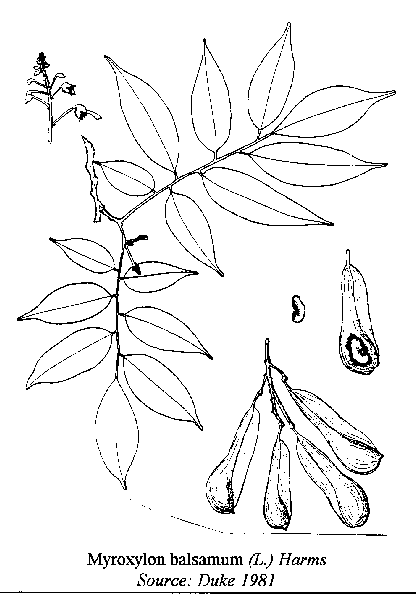
Myroxylon: balsam and much more
NFTA 95-03, June 1995
A quick guide to useful nitrogen fixing trees from around the world
Native to Central and South America, representatives of Myroxylon are used in folk medicine, as shade trees for cultivated crops, ornamentals, and for fine timber. Balsam and its essential oil are used to flavor baked goods, candy, chewing gum, gelatin, ice cream, pudding, soft drinks and syrups, and as incense in churches. Balsam oil is also used in perfume, cosmetic and soap industries. Seeds are used to flavor aguardiente, a popular alcoholic beverage in Latin America (Duke 1981).
Common names include: bálsamo, palo de bálsamo (Spanish America in general), cedro chino, nabal (Mexico), chirraca, sándalo (Costa Rica), tache, tolú (Colombia), estoraque (Peru), cabreúva vermelha (Brazil), incienso, and quina (Argentina)(Chudnoff 1984).
 Botany
Botany
Myroxylon balsamum (L.) Harms (family Leguminosae, subfamily Papilionoideae) grows to 34 m in height and 1 m in diameter. The bark is generally gray and spotted with yellow rough areas. The 3-11 leaves are alternate, evergreen and oddly pinnate, 6-9 cm long and 3-4 cm wide (Duke 1981), and have scattered, translucent, glandular oil dots or lines (Allen and Allen 1981). Flowers are whitish, and the corolla contains 5 petals (Fuentes, 1993). The winged pod is 8-13 cm long and 2.5 cm broad and contains one seed at the tip (Duke 1981).
There is confusion about the number of species and varieties in the genus Myroxylon. Wiersema et al. (1990) reports two species: M. balsamum (L.) Harms native to southern Mexico, Central America, Colombia and Venezuela and; M. peruiferum L.f. native to northwest Argentina, Bolivia, Brazil, Colombia and Peru. Duke (1981) reports one species in South America M. balsamum (L.) Harms. In Brazil Lorenzi (1992) reports M. balsamum (L.) Harms and M. peruiferum L.f. as synonymous.
Wiersema et al. (1990) also reports two varieties: M. balsamum var. balsamum in Panama, Colombia and Venezuela; and M. balsamum var. pereirae (Royle) Harms from southern Mexico through Central America. Duke (1981) reports only one variety-M. balsamum var. pereirae (Royle) Harms-distributed along the Pacific Coast jungles of Central America.
Ecology
Myroxylon balsamum grows in areas with annual precipitation ranging from 1350-4030 mm (average 2640 mm), annual mean temperature of 23-27ºC, and soils with pH 5-8 (Duke 1981). In northwestern El Salvador it grows from 450-700 m altitude in an area known as the “balsam zone” (Fuentes 1993).
Myroxylon balsamum var. pereirae is reported to grow on poor but well-drained soils, at altitudes up to 600 m (Duke 1981).
Distribution
Representatives of the genus are found in southern Mexico, Central America, Venezuela, Colombia, Ecuador, Peru, Bolivia, Argentina and Brazil. Myroxylon balsamum var. pereirae has been introduced to southern Florida, Ceylon, India and West Africa (Duke 1981).
Uses
Gum. Myroxylon balsamum var. balsamum and M. balsamum var. pereirae yield gums called tolu and Peru balsam, respectively. These gums are used mainly as a flavoring in cough syrups, soft drinks, confectioneries, ice cream and chewing gums (Duke 1981).
Trees are wounded to collect gum by three methods. 1) V-shaped cuts are made in the bark taking care not to girdle the tree and cups are placed under cuts to collect gum. 2) Trees are burned at the base. Strips of bark are pulled off, crushed and placed in hot water to soften the balsam and facilitate its flow. The cooled balsam sinks to the bottom and can be separated (Duke 1981). 3) Sections of the tree trunk are beaten with a wooden club and then vertical incisions 8 cm wide are made in the bark. A few days later the incisions are heated with fire to stimulate gum flow—incisions are not burned. Rags are placed over the incisions and removed when they are saturated. Crude presses are used to extract gum from the rags (Fuentes 1993).
Gum harvesting begins on 20 to 30-year-old trees with minimum diameters of 12-15 cm (Fuentes 1993). Twenty-year-old trees yield about 3 kg of gum per year (Allen and Allen 1981). With proper management trees yield gum for 30 to 40 years. Prices per half kilogram of unrefined and refined gum in El Salvador in 1993 were approximately 17 and 24 colones, respectively (Fuentes 1993). This is US$2.00-3.00 at current exchange rates.
El Salvador, a major producer of Peru balsam, exported about 48 MT annually in the late 1970’s and early 1980’s. Tolu balsam is produced in Colombia, the main source, Venezuela and the West Indies (Duke 1981).
Oil. Balsam gum contains about 60% cinnamein, a volatile oil extracted by steam distillation. The oil is used in high-grade perfume, cosmetic and soap industries (Duke 1981).
Wood. Balsam wood is used for flooring, furniture, interior trim, turnery and railroad ties. It is moderately difficult to work but can be finished smoothly with a high natural polish. Heartwood is reddish brown, turning deep red or purplish upon exposure, and very resistant to attack by decay fungi. Specific gravity is 0.74-0.81. Shrinkage values from green to ovendry are very low for a wood of this density (Chudnoff 1984).
Folk medicine. Tolu balsam is used as a feeble expectorant in cough mixtures, and as an inhalant for catarrh and bronchitis. Peru balsam is used extensively as a local protectant, rubefacient, parasiticide in certain skin diseases, antiseptic, and applied externally as an ointment, or in alcoholic solutions. It is rarely used internally as an expectorant. Alcoholic extracts of tolu and Peru balsam inhibit Mycobacterium tuberculosis (Duke 1981).
Agroforestry. Myroxylon balsamum (L.) Harms is used in El Salvador as a shade tree in coffee plantations. There are no government initiatives to promote formal planting of the species—it is propagated mainly through natural regeneration (Fuentes 1993).
Silviculture
Seed collection. Seeds are wind dispersed and may be collected from the tree as they begin to mature. Balsam trees in Brazil flower from July to September and set seed in October and November. There are approximately 1,700 seed per kilogram (Lorenzi 1992).
Propagation. Seed should be planted in a mixture of clay and organic matter to a depth of .5 cm, covered with fine soil and watered daily. Germination beds or containers should be partially shaded. Seeds germinate (greater than 50%) in 15-30 days. Seedlings are ready for outplanting in 5 months. Seedlings grow to 2.5 m in 2 years (Lorenzi 1992).
Symbiosis
Allen and Allen (1981) report nodulation of Myroxylon balsamum. Nodulation of M. balsamum has not been reported in Brasil (S.M. de Faria, personal communication).
Limitations
Myroxylon balsamum (L.) Harms var. balsamum and M. balsamum (L.) Harms var. pereirae are attacked by a number of fungi: Meliola xylosmae, Myiocopron pereirae, Peckia pereirae, Phylosticta myroxyli, Phomopsis sp. and Tabutia xylosmae (Duke 1981).
References
Allen, O.N. and Allen, E.K. 1981. The Leguminosae: a source book of characteristics, uses and nodulation. Madison, WI (USA): The University of Wisconsin Press, p. 453.
Chudnoff, M. 1984. Tropical timbers of the world. Agricultural handbook number 607. Washington, DC: U.S. Department of Agriculture, Forest Service, p. 113.
Duke, J. 1981. Handbook of legumes of world economic importance. New York, NY: Plenum Press, pp. 173-77.
Fuentes, R.E. 1993. El bálsamo en El Salvador: una especie con potencial económico. Revista Forestal Centroamericana. No. 6, Año 2. Turrialba, Costa Rica: CATIE, pp. 38-41.
Lorenzi, H. 1992. Árvores Brasileiras: manual de identificação e cultivo de plantas arbóreas nativas do Brasil. Nova Odessa, SP: Editora Plantarium, p. 220.
Wiersema, J.H., Kirkbride, J.H., Jr. and Gunn, C.R. 1990. Legume (Fabaceae) nomenclature in the USDA germ-plasm system. Technical Bulletin No. 1757: U.S. Department of Agriculture, pp. 371-72.
Written by Mark H. Powell, Program Officer, Winrock International.
A publication of the Forest, Farm, and Community Tree Network (FACT Net)
